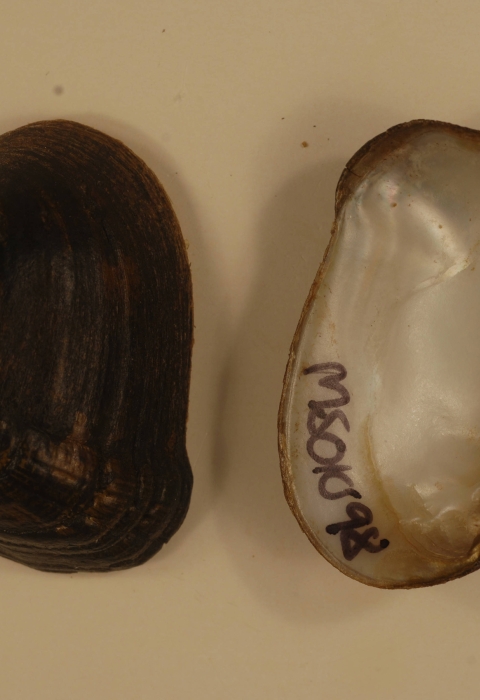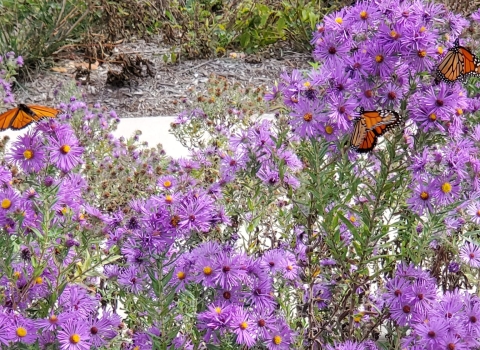As part of an agency-wide effort to advance the recovery of our nation’s most imperiled species, the U.S. Fish and Wildlife Service has made publicly available draft revisions for 21 recovery plans that provide a recovery roadmap for 43 federally protected species. This batch of recovery plan revisions is part of the Department of the Interior’s Agency Priority Performance Goals. The effort calls for all recovery plans to include quantitative criteria on what constitutes recovery by September 2019.
Recovery plans are non-regulatory guidance documents that identify, organize and prioritize recovery actions, set measurable recovery objectives, and include time and cost estimates. In total, the Service will revise up to 182 recovery plans covering some 305 species listed under the ESA.
The Service’s success in preventing extinctions and recovering species is due to ESA-inspired partnerships with diverse stakeholders, such as state, federal, and tribal wildlife agencies, industry, conservation groups and citizens. Each species for which recovery criteria are being revised in this effort has undergone or is currently undergoing a status review that considers the best scientific and commercial data that have become available since the species’ listing or most recent status review. This information includes: (1) the biology of the species, (2) habitat conditions, (3) conservation measures that have benefitted the species, (4) threat status and trends in relation to the five listing factors, and (5) other information, data, or corrections.
As such, these revisions reflect scientific and informational updates, which have been gained from years of collaborative work with our partners. Revisions benefit endangered and threatened species, our partners, and the public by sharing the best available information about what is really needed to achieve recovery.
Under guidance established in 2010, partial revisions, such as amendments, allow the Service to efficiently and effectively update recovery plans with the latest science and information when a recovery plan may not warrant the time or resources required to undertake a full revision of the plan. (This batch includes both amendments and full recovery plan revisions, as noted in below table.)
The document appears today in the Federal Register Reading Room here: https://www.federalregister.gov/public-inspection. There will be a 30-day comment period on the proposed revisions, ending on September 5, 2019.
We are requesting submission of any information that enhances understanding of the: (1) species’ biology and threats, and the (2) recovery needs and related implementation issues or concerns. We seek to ensure that we have assembled, considered and incorporated the best available scientific and commercial information into the draft recovery plan revisions for these 43 species.
The plan revisions cover the following species:
Table 1. List of Animals in Batch
Common Name | Current Range | Recovery Plan Name | Internet Availability of Proposed Recovery Plan Revision |
Southern combshell | AL, MS | Five Tombigbee River Mussels Recovery Plan2 | |
Black clubshell | AL, MS | ||
Fat pocketbook | AR, IL, IN, KY, LA, MO, MS, TN | A Recovery Plan for the Fat Pocketbook Pearly Mussel Potamilus capax2 | https://ecos.fws.gov/docs/recovery_plan/Fat%20Pocketbook%20Mussel%20Recovery%20Plan%20Amendment.pdf |
Alabama redbellied turtle | AL, MS | Draft Revised Recovery Plan for the Alabama Red-Bellied Turtle (Pseudemys alabamensis) 3 | |
Dusky gopher frog | AL, MS | Dusky Gopher Frog (Rana sevosa) Recovery Plan2 | https://ecos.fws.gov/docs/recovery_plan/Dusky%20Gopher%20Frog%20Recovery%20Plan%20Amendment.pdf |
Alabama cavefish | AL | Alabama Cavefish Speoplatyrhinus poulsoni Recovery Plan (Second Revision) 2 | https://ecos.fws.gov/docs/recovery_plan/Alabama%20Cavefish%20Recovery%20Plan%20Amendment.pdf |
Alabama beach mouse | AL | Recovery Plan for the Alabama Beach Mouse (Peromyscus polionotus ammobates), Perdido Key Beach Mouse (P. p. trissyllepsis), and Choctawhatchee Beach Mouse (P. p. allophrys) 2 | https://ecos.fws.gov/docs/recovery_plan/Alabama%20Beach%20Mouse%20Recovery%20Plan%20Amendment.pdf |
Choctawhatchee beach mouse | FL | ||
Perdido Key beach mouse | AL, FL | ||
Ochlockonee moccasinshell | FL, GA | Recovery Plan for Endangered Fat Threeridge, Shinyrayed Pocketbook, Gulf Moccasinshell, Oval Pigtoe and Threatened Chipola Slabshell, and Purple bankclimber2 | |
Florida scrub-jay | FL | Draft Revised Recovery Plan for the Florida Scrub-Jay (Aphelocoma coerulescens) 3 | https://ecos.fws.gov/docs/recovery_plan/Florida%20Scrub-Jay%20Draft%20Revised%20Recovery%20Plan.pdf |
American crocodile | FL | South Florida Multi-Species Recovery Plan2 | https://ecos.fws.gov/docs/recovery_plan/American%20Crocodile%20Recovery%20Plan%20Amendment.pdf |
Snail kite | FL | https://ecos.fws.gov/docs/recovery_plan/Everglade%20Snail%20Kite%20Recovery%20Plan%20Amendment.pdf | |
Eastern indigo snake | AL, FL, GA | Draft Revised Recovery Plan for the Eastern Indigo Snake3 | |
Amber darter | GA, TN | Draft Revised Recovery Plan for the Amber Darter (Percina antesella) 3 | https://ecos.fws.gov/docs/recovery_plan/Amber%20Darter%20Draft%20Revised%20Recovery%20Plan.pdf |
Conasauga logperch | GA, TN | Draft Revised Recovery Plan for the Conasauga Logperch (Percina jenkinsi) 3 | https://ecos.fws.gov/docs/recovery_plan/Conasauga%20Logperch%20Draft%20Revised%20Recovery%20Plan.pdf |
Louisiana pearlshell | AR, LA | Draft Revised Recovery Plan for the Louisiana Pearlshell (Margaritifera hembeli) 3 | |
Puerto Rican sharp-shinned hawk | Puerto Rico | Puerto Rican Broad-Winged Hawk and Puerto Rican Sharp-Shinned Hawk Recovery Plan2 | |
Puerto Rican broad-winged hawk | Puerto Rico | ||
Puerto Rican boa | Puerto Rico | Recovery Plan for the Puerto Rican Boa2 | https://ecos.fws.gov/docs/recovery_plan/Puerto%20Rican%20Boa%20Recovery%20Plan%20Amendment.pdf |
Virgin Islands tree boa | Puerto Rico, Virgin Islands | Recovery Plan for the Virgin Islands Tree Boa (Epicrates monensis granti) 2 |
Table 2. List of Plants in Batch
Common Name | Current Range | Recovery Plan Name | Internet Availability of Proposed Recovery Plan Revision |
Morefield’s leather flower | AL, TN | Morefield’s Leather Flower Clematis morefieldii Recovery Plan2 | |
Alabama canebrake pitcher-plant | AL | Alabama Canebrake Pitcher Plant (Sarracenia rubra ssp. alabamensis) Recovery Plan2 | |
Apalachicola rosemary | FL | Recovery Plan for Apalachicola Rosemary (Conradina glabra) 2 | https://ecos.fws.gov/docs/recovery_plan/Apalachicola%20Rosemary%20Recovery%20Plan%20Amendment.pdf |
Chapman rhododendron | FL | Recovery Plan for Chapman’s Rhododendron, Rododendron chapmanii2 | https://ecos.fws.gov/docs/recovery_plan/Chapmans%20Rhododendron%20Recovery%20Plan%20Amendment.pdf |
Gentian pinkroot | AL, FL | Recovery Plan for Spigelia gentianoides (Gentian pinkroot) 2 | https://ecos.fws.gov/docs/recovery_plan/Gentian%20Pinkroot%20Recovery%20Plan%20Amendment.pdf |
Four-petal pawpaw | FL | South Florida Multi-Species Recovery Plan2 | https://ecos.fws.gov/docs/recovery_plan/Four%20Petal%20PawPaw%20Recovery%20Plan%20Amendment.pdf |
Fragrant prickly-apple | FL | https://ecos.fws.gov/docs/recovery_plan/Fragrant%20Prickly%20Apple%20Recovery%20Plan%20Amendment.pdf | |
Florida perforate cladonia | FL | ||
Short-leaved rosemary | FL | ||
Avon Park harebells | FL | ||
Garrett’s mint | FL | ||
Scrub mint | FL | ||
Snakeroot | FL | ||
Highlands scrub hypericum | FL | ||
Scrub blazingstar | FL | ||
Lewton’s polygala | FL | ||
Wireweed | FL | ||
Sandlace | FL | ||
Carter’s mustard | FL | ||
Florida ziziphus | FL | ||
Okeechobee gourd | FL | https://ecos.fws.gov/docs/recovery_plan/Okeechobee%20Gourd%20Recovery%20Plan%20Amendment.pdf | |
Key tree-cactus | FL | https://ecos.fws.gov/docs/recovery_plan/Key%20Tree%20Cactus%20Recovery%20Plan%20Amendment.pdf |
The U.S. Fish and Wildlife Service works with others to conserve, protect, and enhance fish, wildlife, plants, and their habitats for the continuing benefit of the American people. For more information, visit www.fws.gov, or connect with us through any of these social media channels: Facebook, Twitter, Flickr, YouTube.


